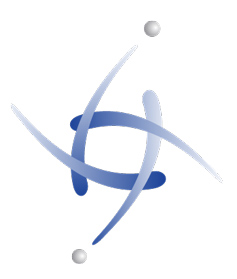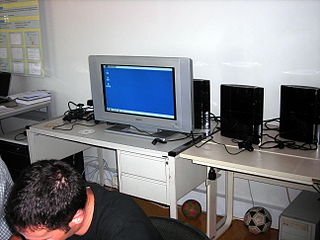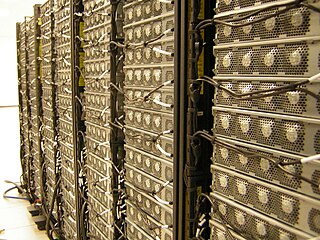
A supercomputer is a computer with a high level of performance as compared to a general-purpose computer. The performance of a supercomputer is commonly measured in floating-point operations per second (FLOPS) instead of million instructions per second (MIPS). Since 2017, there are supercomputers which can perform over 1017 FLOPS (a hundred quadrillion FLOPS, 100 petaFLOPS or 100 PFLOPS).

A Beowulf cluster is a computer cluster of what are normally identical, commodity-grade computers networked into a small local area network with libraries and programs installed which allow processing to be shared among them. The result is a high-performance parallel computing cluster from inexpensive personal computer hardware.

InfiniBand (IB) is a computer networking communications standard used in high-performance computing that features very high throughput and very low latency. It is used for data interconnect both among and within computers. InfiniBand is also used as either a direct or switched interconnect between servers and storage systems, as well as an interconnect between storage systems. It is designed to be scalable and uses a switched fabric network topology. By 2014, it was the most commonly used interconnect in the TOP500 list of supercomputers, until about 2016.

Quadrics was a supercomputer company formed in 1996 as a joint venture between Alenia Spazio and the technical team from Meiko Scientific. They produced hardware and software for clustering commodity computer systems into massively parallel systems. Their highpoint was in June 2003 when six out of the ten fastest supercomputers in the world were based on Quadrics' interconnect. They officially closed on June 29, 2009.

MareNostrum is the main supercomputer in the Barcelona Supercomputing Center. It is the most powerful supercomputer in Spain, one of thirteen supercomputers in the Spanish Supercomputing Network and one of the seven supercomputers of the European infrastructure PRACE.

TeraGrid was an e-Science grid computing infrastructure combining resources at eleven partner sites. The project started in 2001 and operated from 2004 through 2011.

The considerable computing capability of the PlayStation 3's Cell microprocessors has raised interest in using multiple, networked PS3s for various tasks that require affordable high-performance computing.
Steele is a supercomputer that was installed at Purdue University on May 5, 2008. The high-performance computing cluster is operated by Information Technology at Purdue (ITaP), the university's central information technology organization. ITaP also operates clusters named Coates built in 2009, Rossmann built in 2010, and Hansen and Carter built in 2011. Steele was the largest campus supercomputer in the Big Ten outside a national center when built. It ranked 104th on the November 2008 TOP500 Supercomputer Sites list.

A computer cluster is a set of computers that work together so that they can be viewed as a single system. Unlike grid computers, computer clusters have each node set to perform the same task, controlled and scheduled by software.
The Cray CX1 is a deskside high-performance workstation designed by Cray Inc., based on the x86-64 processor architecture. It was launched on September 16, 2008, and was discontinued in early 2012. It comprises a single chassis blade server design that supports a maximum of eight modular single-width blades, giving up to 96 processor cores. Computational load can be run independently on each blade and/or combined using clustering techniques.
DiaGrid is a large, multicampus distributed research computing network utilizing the HTCondor system and centered at Purdue University in West Lafayette, Indiana. In 2012, it included nearly 43,000 processors representing 301 teraflops of computing power. DiaGrid received a Campus Technology Innovators Award from Campus Technology magazine and an IDG InfoWorld 100 Award in 2009 and was employed at the SC09 supercomputing conference in Portland, Ore., to capture nearly 150 days of compute time for science jobs.
Clarence Leroy “Ben” Coates was an American computer scientist and engineer known for his work on waveform recognition devices, circuit gates and accumulators.
QPACE is a massively parallel and scalable supercomputer designed for applications in lattice quantum chromodynamics.

Fabric computing or unified computing involves constructing a computing fabric consisting of interconnected nodes that look like a weave or a fabric when seen collectively from a distance.

SciNet is a consortium of the University of Toronto and affiliated Ontario hospitals. It has received funding from both the federal and provincial government, Faculties at the University of Toronto, and affiliated hospitals.
Brutus is the central high-performance cluster of ETH Zurich. It was introduced to the public in May 2008. A new computing cluster called EULER has been announced and opened to the public in May 2014.

Japan operates a number of centers for supercomputing which hold world records in speed, with the K computer becoming the world's fastest in June 2011. and Fugaku took the lead in June 2020, and furthered it, as of November 2020, to 3 times faster than number two computer.
Carter is a supercomputer installed at Purdue University in the fall of 2011 in a partnership with Intel. The high-performance computing cluster is operated by Information Technology at Purdue (ITaP), the university's central information technology organization. ITaP also operates clusters named Steele built in 2008, Coates built in 2009, Rossmann built in 2010, and Hansen built in the summer of 2011. Carter was the fastest campus supercomputer in the U.S. outside a national center when built. It was one of the first clusters to employ Intel's second generation Xenon E-5 "Sandy Bridge" processor and ranked 54th on the November 2011 TOP500 list, making it Purdue's first Top 100-ranked research computing system.
Rossmann is a supercomputer at Purdue University that went into production September 1, 2010. The high-performance computing cluster is operated by Information Technology at Purdue (ITaP), the university's central information technology organization. ITaP also operates clusters named Steele built in 2008, Coates built in 2009, Hansen built in the summer of 2011 and Carter built in the fall of 2012 in partnership with Intel. Rossmann ranked 126 on the November 2010 TOP500 list.
The Holland Computing Center, often abbreviated HCC, is the high-performance computing core for the University of Nebraska System. HCC has locations in both the University of Nebraska-Lincoln June and Paul Schorr III Center for Computer Science & Engineering and the University of Nebraska Omaha Peter Kiewit Institute. The center was named after Omaha businessman Richard Holland who donated considerably to the university for the project.










